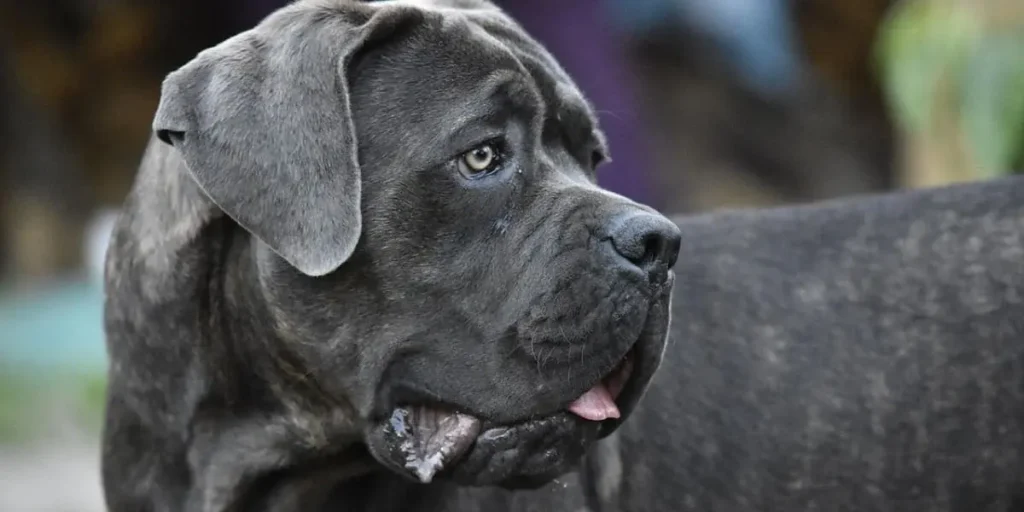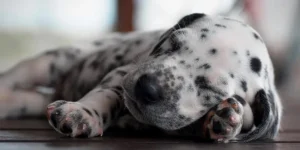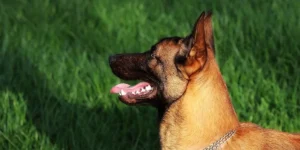Table of contents
Also known as Branchiero Siciliano, Italian Courtyard Dog, or Italian Corso Dog, the Cane Corso is Italy’s famous guardian breed. Beyond being a protector, it is a devoted companion, loyal to its family, good with or without children, and known for its strength and elegance.
Breed History
The Cane Corso, or Italian Courtyard Dog, descends directly from the great Roman molossers and the Canis pugnax used in ancient Rome. Its Latin name means ‘protector’ or ‘guardian of farms.’ For centuries, Italians kept this dog by their side to guard property, family, livestock, and to accompany them on hunts.
The breed is still common in southern Italy today. In the 20th century, it nearly disappeared but was revived in the 1970s thanks to enthusiasts who formed an association. Italy officially recognized the breed in 1979.
Physical Characteristics
- Coat: Short.
- Colors: Black, lead gray, slate, light gray, light fawn, deer fawn, dark fawn, brindle. Some are referred to as ‘blue Cane Corso.’
- Head: Broad, slightly arched skull with a pronounced stop. Wide and deep muzzle.
- Ears: Triangular, falling forward. Usually chestnut, sometimes white or speckled.
- Eyes: Medium-sized.
- Body: Compact, strong, and muscular.
- Tail: Set high, thick at the base, tapering toward the tip.
Temperament and Character
The Cane Corso is intelligent, energetic, and balanced. A natural guardian, it is docile and affectionate with its owner and family, including children. It only becomes a fierce defender when truly necessary. While relatively easy to train with proper methods, it can be stubborn, requiring firm and experienced handling. Once convinced of the usefulness of its task, it performs with dedication. Primarily a guard dog, the Cane Corso excels at deterrence and protection.
Behavior with Others
The Cane Corso is loyal and affectionate with children, generally sociable with other animals, and cautious with strangers. It requires proper socialization to maintain balance. With confidence and clear leadership, it becomes a trustworthy and protective family companion.
Training
Cane Corso training should be firm but not harsh. Its strength and strong temperament make it unsuitable for first-time owners without guidance. Beginners are advised to seek help from a professional trainer. Owners must remain confident and consistent, since this intelligent breed respects authority when it understands the purpose of exercises.
Living Conditions
Although it can adapt to indoor living, the Cane Corso thrives outdoors. Its coat sheds little, it barks only when necessary, and it does not drool excessively. Highly athletic, it needs large spaces for exercise, making rural settings or houses with gardens ideal. It must be walked often and for long periods, and can accompany its owner jogging or cycling.
Health
The Cane Corso is strong and generally healthy but can be predisposed to certain conditions:
- Major concerns: Hip dysplasia, elbow dysplasia, epilepsy, cruciate ligament rupture, gastric torsion.
- Occasional concerns: Demodicosis, ectropion, entropion.
- Suggested tests: Hip, elbow, and eye checks.
- Average litter size: 2 to 12 puppies.
- Hypoallergenic breed: No.
Life Expectancy
The Cane Corso has a life expectancy of 10 to 12 years.
Care and Grooming
The Cane Corso sheds twice a year. Grooming needs are minimal: brushing occasionally and checking the coat after walks. Introduce brushing and eye cleaning early so the dog becomes accustomed. Teeth should be brushed regularly to avoid tartar buildup, and nails trimmed to prevent discomfort. Eyes and ears must be checked often for infection.
Price and Budget
| Category | Minimum | Maximum |
| Purchase Price | $1000 | $1500 |
| Annual Care Cost | $1750 | $1800 |
Name Ideas for a Cane Corso
- Male: Crockdur, Diabolo, Elvis, Franklin, Gangster, Hagrid, Nemo, Rock, Smoke, Tolstoy.
- Female: Aqua, Belle, Citrouille, Elly, Grenade, Lizzi, Maddy, Nana, Olga, Pearl.
Diet
The Cane Corso can be fed high-quality commercial dog food, preferably premium kibble. Meals should be divided into two per day, and portions adjusted based on daily energy expenditure.
Physical Activity
A highly athletic breed, the Cane Corso requires regular walks and exercise to maintain balance and well-being. It can participate in canine sports such as agility, obedience, tracking, and scent work. Historically used for hunting large game, its excellent sense of smell also allows it to excel in utility tasks. Activities like cycling or jogging alongside its owner strengthen the bond.
Famous Cane Corsos
Gandalf, a Cane Corso owned by trainer Adeline Jalade, appeared in the French film *Dans la cour* (2014), directed by Pierre Salvadori and starring Catherine Deneuve. The actress was charmed by the affectionate and playful dog during filming.
Competitions
- FCI: Fédération Cynologique Internationale
- AKC: American Kennel Club
- ANKC: Australian National Kennel Council
- CKC: Canadian Kennel Club
- KC: The Kennel Club (UK)
- UKC: United Kennel Club
- NZKC: New Zealand Kennel Club
FCI Information
- FCI number: 343
- Group: Group 2 – Pinscher and Schnauzer types, Molossers, Swiss Mountain and Cattle Dogs, and other breeds.
- Recognized by FCI since 2007.
- Sources:
- American Kennel Club


